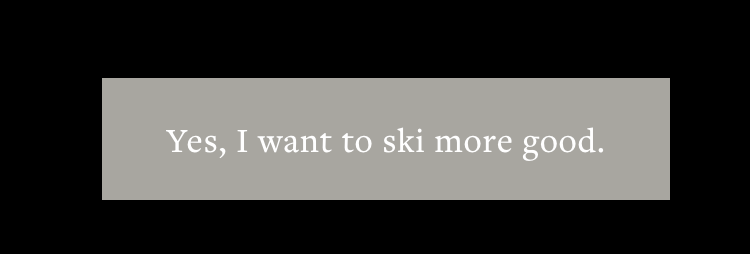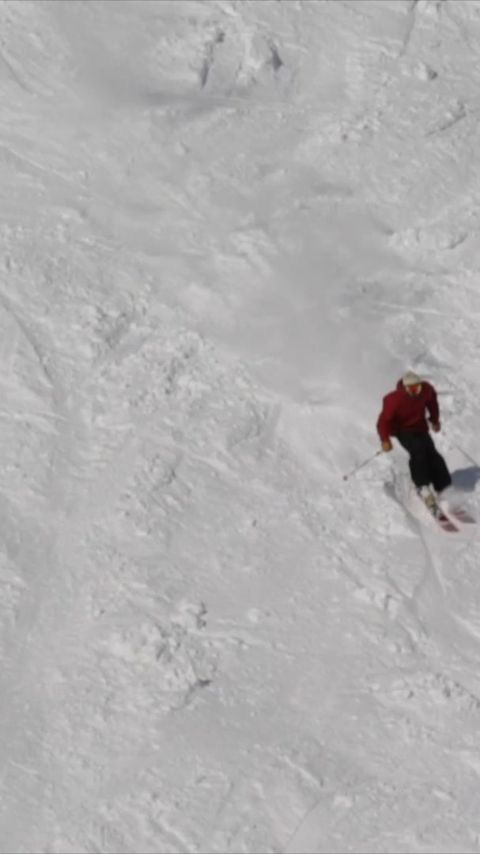
According to one of my close friends who keeps track of this kind of thing, “Max Hammer is prob the best skier on the planet.”
That’s a real text message from a person who has his fingers on the pulse of skiing. I’d argue that every single subscriber to The Ski Phoenix owns at least one thing that the person who sent this text designed. He doesn’t mess around.
Here’s how the text exchange played out…
He who shall not be named (Person X):
Imo Max Hammer is prob the best skier on the planet.
Me:
Hadley’s brother?
Person X:
yes
Me:
Josh introduced me to Max at the VC in Jackson Hole years ago before a TGR premiere. He’s fun to watch. “Best on the planet” is a hot take, tho
Person X:
haha
I have never seen anyone ski that smooth
Im just happy to watch him ski
He is an artist
Ask tgr they would say “the best” as well
I trust “Person X.” His hot take via a text exchange compelled me to send Max an Instagram DM.
If you want to become a better skier, you should consider hitting Max up. All you have to do is click the button below to “ski more good.” It’s that easy. Go ahead, lick the stamp and send it.
Max Hammer will help you Ski.More.Good. It’s his current project. It’s his mission. I say “mission” not in the militaristic way but more in the building community, sharing your passion and answering your life’s calling kind of way. It’s like a devout Mormon’s mission except this is aimed at galvanizing people who want to focus on the nuances of ski technique in varied terrain.
“I have my way of praying, as you no doubt have yours,” writes poet Mary Oliver in How I Go To The Woods. Respect!
First, some soundbites to validate Max—as if he needs it.
How does Patagonia describe Max Hammer?
“An athlete, a cowboy or an artist? When he was young, Max couldn't decide what he wanted to be when he grew up. He never imagined he could find a way to be all three. Today, Max exerts the physical energy of an athlete, intuits weather and land like a cowboy and keeps his artistic mind firing whenever he navigates treacherous terrain—all in his pursuit of backcountry descents.”
What story did Matt Hansen write about Max Hammer for Powder?
“The story behind the first person with Down Syndrome to climb the Grand.” 1

10 nuggets that give a abbreviated rundown of Max’s highlights (some pulled directly from Patagonia):
Member U.S. Ski Team from 2006–2008
NorAm Overall Super Combined Champion, 2008
Repeat Dick's Ditch Champion, Jackson Hole Mountain Resort, Wyoming
Featured in Teton Gravity Research films The Dream Factory, Way of Life and Almost Ablaze
Featured in the film Wyoming Triumph by KGB Productions
Ski guide for Exum Mountain Guides
Longtime coach for Jackson Hole Ski Club
Current sponsors are Patagonia and WNDR Alpine
Is that enough cred? I hope so. Max is legit. He’s also super humble, empathetic, thoughtful and earnest.
“While I don't like rules, I do like boundaries,” says Max. “There is infinity within boundaries and I feel most free when the bounds are clear and I can move within them on my own accord.”
But, I digress. Back to how Max can help us enjoy our time clicked into bindings…
“Ski.More.Good is for anyone who wants to know more about the boundaries of skiing so they can move more freely as a unique human sliding on snow,” says Hammer. “The term ‘Ski More Good’ isn't proper for a reason. By approaching with humor and accepting that there is no right way (sorry PSIA), you get to step back and define what skiing more good actually means to you. So, first-timers, racers, rec skiers, moms and dads, kids, backcountry enthusiasts, front-country carvers, jibbers, ice axers, resident experts, and certainly myself can benefit from Ski More Good. Ski More Good is a learning environment, not a sermon, and the goal is to understand and experience the boundaries of what is to ski and what it can mean for you.”
Skiing is a craft. Like writing, hitting a baseball, parenting, noseriding, fly fishing and filmmaking. Skiing is fun, and it also has endless nuanced minutiae that make it a lifelong pursuit of perfection—if you’re here for it. Max Hammer is here for it.
“I have an ingrained mastery goal with the art of skiing. Control on hard snow and soft snow, racing, freeriding, park and pipe, ski-mountaineering, pow-dogging, teaching, and the absence of snow are all included,” says Max.
But how’d he get here? I remember Max’s segments from TGR and KGB films. He’s a far cry from film premieres right now and that’s by design.
“I think what happened with filming with TGR and others is that I felt good about what I had learned from the experience but didn't want to stall out when there was much more to learn,” says Max. “From there, I sort of went underground learning about uphill mountain travel and avalanche conditions. I studied with a bunch of incredible folks, helped evacuate three best friends from serious accidents, and mellowed my manic for speed (maybe).”
In addition to Ski. More. Good, rearing two boys, being a partner to his love and being Bob’s best friend, Max makes art, drops nuggets of short films every now and then, drops cell phone calls during interviews because he’s “about to run through a tunnel,” carries a dumb phone so he doesn’t get sucked into the dark vortex of scrolling on social media and leans in when asked how he reconciles spraying on Instagram—a job requirement of pro skiers—with humility.
“I hate arbitrary rules and being told what to do,” says Max. “Ski resorts are hard for me cause when I see a rope my first thought is to jump it. Filming can be taxing cause I don't like waiting around while on skis cause that's precious time to waste. The pro skier track can feel like a box, so I scrapped outta that one and built my own box to play in. I have no beef with filming (in fact I own a production company, ha), but I don't like IG because it feels like you have to perform at all times. While I am way down for a performance, I want those times to be special and not an everyday occurrence. Everyday performance is a recipe for burning out instead of stoking up.”
Rather than paraphrasing Max’s foundational philosophy, here it is verbatim from the website2:
There is no correct way to ski. No truth. No secrets. No perfect turn.
The Ski More Good philosophy is based in intention, action & observation.
Skiing is a way to get from the top of a mountain to the bottom. It can bring many emotions, including joy, but mechanically it is a simply a form of transportation. It is the act of moving your body in coordination with your equipment in an effort to control the transportation.
Skiing is not possible without a mountain, gravity, & snow, all of which you have no direct control over.
The three controllable aspects are your body, your equipment, and your line. Here they are represented by three objects: a ball, stick and string.
The ball represents your body. A ball cannot fall and it is infinitely mobile. Other shapes are stable or mobile, but the sphere is both. Be a ball.
The center of this ball is a point in your body cradled by your hips. It is three finger widths below your belly button and two finger widths deep. From this point, there is a radial line to the point of contact with the snow surface. The point of contact can be one foot, both feet, or the other foot. To be a sphere, this radial line ought to be perpendicular to the surface of your skis at all times. Let’s call this the Weighted Line.
There are other radial lines through your body, the ball, including one from your center that travels up through your spine and out the top of your head. Imaging this line as a string that is always in tension, and always perpendicular to gravity. Let’s call this the Taut Line.
Imagine your skis moving underneath you from left to right, your weight must transfer from foot to foot in order to keep the line perpendicular to your skis. The taut line however must be remain perpendicular to gravity, therefore straight up. The angle between the Weighted Line and the Taut Line are what most ski instructors refer to as angulation. Angulation is how your body counteracts the force of gravity, while simultaneously weighting and controlling your skis. The proper angle depends on the terrain, snow, your line and the properties of your skis.
The stick represents your skis. You get two of them, sticks.
A stick has a few properties for you to consider:
Bendable - i.e. Flexion
Rollable - i.e. Edging
Pivotable - i.e. Rotation
*Other properties include flotation and torsion but they are not addressed here.
[CLICK HERE to get weirder, there’s a lot more if this piques your interest and inspires you to go out and get reps on snow.]
To wrap it up, here are my seven takeaways from chats with Max Hammer:
I don’t know if Max is “the best skier on the planet.” I don’t care. The superlative bullshit is going to stay in high school yearbooks and late-night hot-take text messages with friends.
Max is cool. Max cares.
He can help us ski better.
Max read something on The Ski Phoenix and that’s humbling! “Those pictures of Andrea Mead Lawrence ripping are psycho! We used to always joke around while skiing Jackson that everything you saw had already been hit by Pepi Stiegler and he did it in leather boots,” he says.
Talking about real-life things with passionate people (including, but not limited to, skiers, artists, storytellers, parents, teachers, engineers, sailors, business leaders, children, etc.) is super refreshing and inspiring.
He also read another thing, which trips me out even more. Here’s his take on “Hot Laps:”
“I think you are spot on with the idea that the environment creates the skier's style. I'll go one step further and say that the environment creates the whole culture. At least that's what I see with Jackson being long, sustained, in the trees and hard to see someone (think swift, silent, deep before that got played out) and Squaw's benchy basins between little steep cliff zones, where watching others ski is natural (Squallywood).”I want to spend time in the mountains with Max.
On that note, here’s what it looks like to ski from Max’s point of view…











